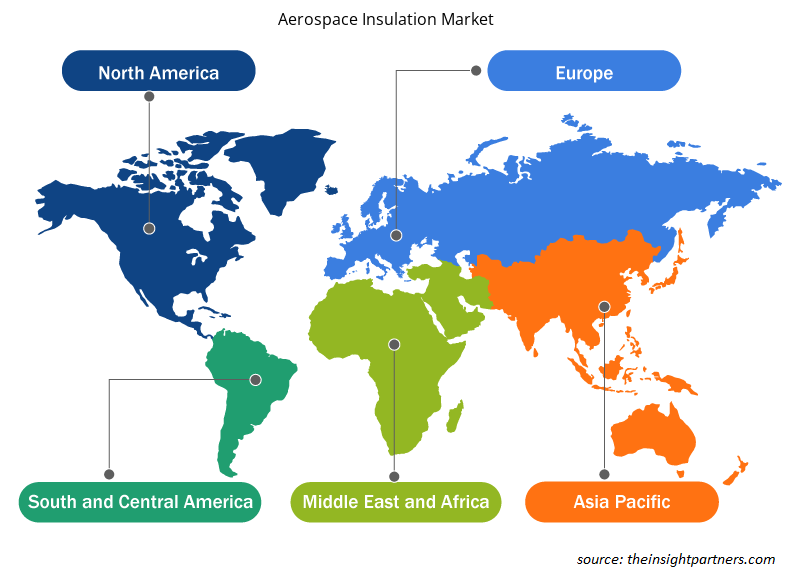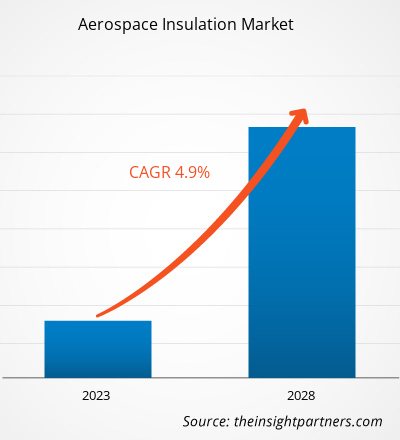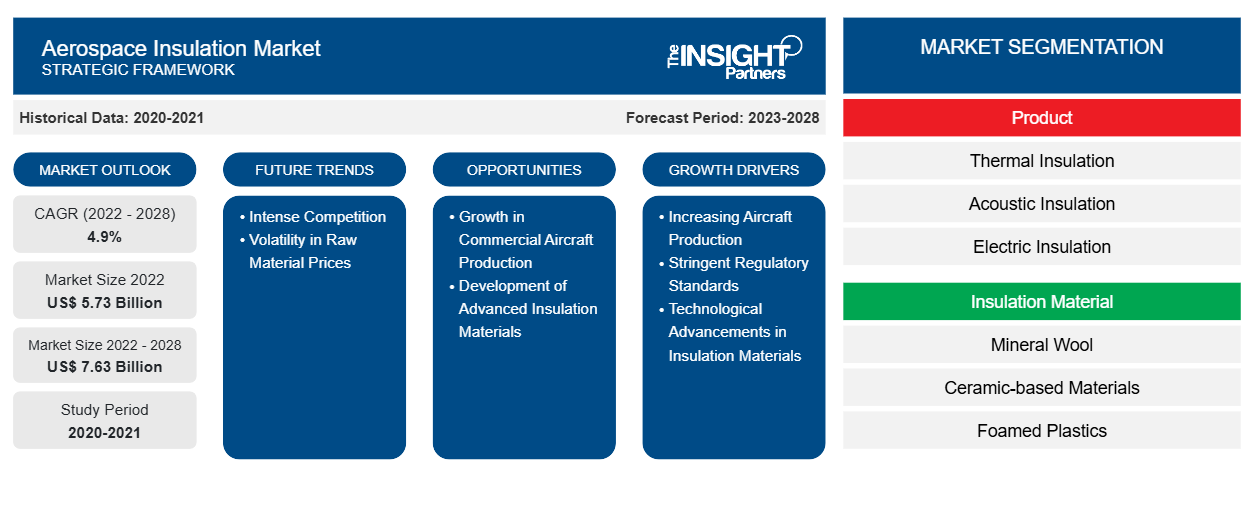Der Markt für Luft- und Raumfahrtisolierungen soll von 5.731,28 Millionen US-Dollar im Jahr 2022 auf 7.633,23 Millionen US-Dollar im Jahr 2028 wachsen; von 2022 bis 2028 wird mit einer durchschnittlichen jährlichen Wachstumsrate von 4,9 % gerechnet.
Unter Luft- und Raumfahrtisolierung versteht man das Material, das in Flugzeugen installiert wird, um die Sicherheit und den Komfort zu verbessern. Die Funktionen des Flugzeugs unter schwierigen klimatischen Bedingungen müssen bestimmten grundlegenden Betriebsabläufen sowie Sicherheitsmaßnahmen in Bezug auf Gewicht, Temperatur und Gesamtleistung entsprechen. Aufgrund von Vorteilen wie geringeren Vibrationen und Geräuschpegeln während der Flugstunden wächst die Nachfrage nach Isoliermaterialien rasant. Die zunehmende Verwendung von Verbundwerkstoffen in Verkehrsflugzeugen dürfte die Entwicklung verschiedener Flugzeugstrukturen vorantreiben, was zu einem erheblichen Branchenpotenzial führt. Die steigende Nachfrage nach leichten Isoliermaterialien und Verbundwerkstoffen in der Verkehrsflugzeug- und Businessjet-Industrie zur Reduzierung des Kabinenlärms wird den Markt in den nächsten Jahren wahrscheinlich antreiben.
Die Isolierung von Flugzeugen spielt eine entscheidende Rolle beim Schutz von Besatzung und Passagieren vor Generatorlärm und eisigen Temperaturen in höheren Lagen. Die steigende Nachfrage nach leichten, treibstoffeffizienten Flugzeugen der neuen Generation und der zunehmenden Bedeutung der Emissionsreduzierung dürfte die Flugzeugproduktion steigern. Die bedeutende Entwicklung der Reisebranche in den Schwellenmärkten und die steigende Zahl der Passagiere im internationalen und inländischen Reiseverkehr sind die Hauptfaktoren, die den globalen Markt für Isolierungen in der Luft- und Raumfahrt antreiben . Laut der International Air Transport Association (IATA) beispielsweise stieg die Gesamtnachfrage nach Flugreisen im April 2022 im Vergleich zum April 2021 um 78,7 %.
Passen Sie diesen Bericht Ihren Anforderungen an
Sie erhalten kostenlos individuelle Anpassungen an jedem Bericht, einschließlich Teilen dieses Berichts oder einer Analyse auf Länderebene, eines Excel-Datenpakets sowie tolle Angebote und Rabatte für Start-ups und Universitäten.
-
Holen Sie sich die wichtigsten Markttrends aus diesem Bericht.Dieses KOSTENLOSE Beispiel umfasst eine Datenanalyse von Markttrends bis hin zu Schätzungen und Prognosen.
Laut der Federal Aviation Administration (FAA) müssen alle Verkehrsflugzeuge über eine Wärme- und Schalldämmung verfügen. Diese Dämmung sorgt dafür, dass der Komfort der Passagiere nicht durch Temperaturschwankungen im Außenbereich beeinträchtigt wird und dass übermäßiger Lärm des Flugzeugs die Kommunikation nicht stört. Derart strenge Vorschriften ermutigen Flugzeughersteller, Dämmmaterial in Flugzeugen zu verwenden, was den Markt für Dämmstoffe in der Luft- und Raumfahrt ankurbelt.
Viele Hersteller von Dämmstoffen für die Luft- und Raumfahrt wie Zotefoams entwickeln leichte Baumaterialien für die Luft- und Raumfahrt, um die Treibstoffeffizienz und Nachhaltigkeit zu steigern. Wärme- und Schalldämmung schützt in den meisten Flugzeugen vor übermäßigem Lärm und übermäßiger Temperatur. Wärme- und Schalldämmung besteht aus einer einzigartigen Hochleistungsfaser, die in einer für Flugzeuge geeigneten Kunststoffhülle eingeschlossen ist, die die Dämmstoffe zusammenhält und gleichzeitig als Feuchtigkeitsbarriere fungiert.
Markteinblicke
Wachstum im Luftverkehrssektor beflügelt den Markt für Luft- und Raumfahrtisolierungen
Der Luftverkehrssektor wächst schnell und dies wird sich in den nächsten Jahren voraussichtlich fortsetzen. Nach Schätzungen der International Air Transport Association (IATA) wird die Nachfrage nach Luftverkehr bis 2036 voraussichtlich um durchschnittlich 4,3 % pro Jahr steigen. Wenn dieses Wachstum bis 2036 erreicht wird, wird die Luftverkehrsbranche im Prognosezeitraum voraussichtlich 15,5 Millionen direkte Arbeitsplätze und 1,5 Billionen US-Dollar BIP zur Weltwirtschaft beitragen. Ein derart starkes Wachstum der Luftverkehrsnachfrage wird zu einer höheren Nachfrage nach Flugzeugen führen. Luft- und Raumfahrtisolierung wird in Flugzeugen verwendet, um den Komfort und die Sicherheit von Flugzeugen und Passagieren zu erhöhen, was den Markt für Luft- und Raumfahrtisolierung im Prognosezeitraum voraussichtlich ankurbeln wird. Darüber hinaus sinken die Kosten für Verbundwerkstoffe kontinuierlich, sodass Flugzeughersteller Verbundwerkstoffe für die Luft- und Raumfahrtisolierung verwenden können. Aufgrund dieser Faktoren wird der Markt im Prognosezeitraum daher schnell florieren.
Produktinformationen
Basierend auf dem Produkt ist der Markt für Luft- und Raumfahrtisolierungen in Wärmedämmung, Schalldämmung, elektrische Isolierung und Schwingungsisolierung unterteilt. Im Jahr 2021 dominierte das Segment Wärmedämmung den Markt und wird im Prognosezeitraum voraussichtlich mit einer schnelleren CAGR wachsen. Verstärkte Forschungs- und Entwicklungsaktivitäten zur Herstellung fortschrittlicher, leichter und nachhaltiger Wärmedämmstoffe kurbeln das Wachstum des Wärmedämmungssegments im Prognosezeitraum an.
3M; TransDigm Group Incorporated; Triumph Group, Inc.; Johns Manville; Morgan Advanced Materials Plc; Polymer Technologies Inc.; Duracote Corporation; Rogers Corporation; DuPont; und BASF SE sind die wichtigsten Akteure auf dem Markt für Luft- und Raumfahrtisolierungen. Die führenden Akteure verfolgen verschiedene Strategien, wie Fusionen und Übernahmen sowie Produkteinführungen, um ihre geografische Präsenz und Kundenbasis zu erweitern.
Regionale Einblicke in den Markt für Luft- und Raumfahrtisolierungen
Die regionalen Trends und Faktoren, die den Markt für Luft- und Raumfahrtisolierungen im Prognosezeitraum beeinflussen, wurden von den Analysten von Insight Partners ausführlich erläutert. In diesem Abschnitt werden auch die Marktsegmente und die Geografie für Luft- und Raumfahrtisolierungen in Nordamerika, Europa, im asiatisch-pazifischen Raum, im Nahen Osten und Afrika sowie in Süd- und Mittelamerika erörtert.

- Erhalten Sie regionale Daten zum Markt für Luft- und Raumfahrtisolierungen
Umfang des Marktberichts zur Luft- und Raumfahrtisolierung
| Berichtsattribut | Details |
|---|---|
| Marktgröße im Jahr 2022 | 5,73 Milliarden US-Dollar |
| Marktgröße bis 2028 | 7,63 Milliarden US-Dollar |
| Globale CAGR (2022 - 2028) | 4,9 % |
| Historische Daten | 2020-2021 |
| Prognosezeitraum | 2023–2028 |
| Abgedeckte Segmente |
Nach Produkt
|
| Abgedeckte Regionen und Länder |
Nordamerika
|
| Marktführer und wichtige Unternehmensprofile |
|
Marktdichte von Luft- und Raumfahrtisolierungen: Auswirkungen auf die Geschäftsdynamik
Der Markt für Luft- und Raumfahrtisolierungen wächst rasant. Dies wird durch die steigende Nachfrage der Endnutzer aufgrund von Faktoren wie sich entwickelnden Verbraucherpräferenzen, technologischen Fortschritten und einem größeren Bewusstsein für die Vorteile des Produkts vorangetrieben. Mit der steigenden Nachfrage erweitern Unternehmen ihr Angebot, entwickeln Innovationen, um die Bedürfnisse der Verbraucher zu erfüllen, und nutzen neue Trends, was das Marktwachstum weiter ankurbelt.
Die Marktteilnehmerdichte bezieht sich auf die Verteilung der Firmen oder Unternehmen, die in einem bestimmten Markt oder einer bestimmten Branche tätig sind. Sie gibt an, wie viele Wettbewerber (Marktteilnehmer) in einem bestimmten Marktraum im Verhältnis zu seiner Größe oder seinem gesamten Marktwert präsent sind.
Die wichtigsten auf dem Markt für Luft- und Raumfahrtisolierung tätigen Unternehmen sind:
- Duracote Corporation
- Rogers Corporation
- DuPont
- BASF SE
- 3M
Haftungsausschluss : Die oben aufgeführten Unternehmen sind nicht in einer bestimmten Reihenfolge aufgeführt.

- Überblick über die wichtigsten Akteure auf dem Markt für Luft- und Raumfahrtisolierung
Bericht-Spotlights
- Fortschrittliche Trends in der Luft- und Raumfahrt-Isolierindustrie helfen den Akteuren bei der Entwicklung wirksamer langfristiger Strategien
- Von Unternehmen verfolgte Geschäftswachstumsstrategien zur Sicherung des Wachstums in entwickelten und sich entwickelnden Märkten
- Quantitative Analyse des globalen Marktes für Luft- und Raumfahrtisolierungen von 2021 bis 2028
- Schätzung des Bedarfs an Luft- und Raumfahrtisolierung in verschiedenen Branchen
- Porters Fünf-Kräfte-Analyse zur Veranschaulichung der Wirksamkeit von Käufern und Lieferanten in der Luft- und Raumfahrt-Isolierindustrie
- Aktuelle Entwicklungen zum Verständnis des Wettbewerbsmarktszenarios und der Nachfrage nach Isolierungen für die Luft- und Raumfahrt
- Markttrends und -aussichten in Verbindung mit Faktoren, die das Wachstum des Marktes für Luft- und Raumfahrtisolierungen bestimmen
- Verstehen der Strategien, die dem kommerziellen Interesse im Hinblick auf das Marktwachstum zugrunde liegen, und Unterstützung des Entscheidungsprozesses
- Marktgröße für Luft- und Raumfahrtisolierungen an verschiedenen Marktknoten
- Detaillierte Übersicht und Segmentierung des Marktes sowie seiner Branchendynamik
- Marktgröße für Luft- und Raumfahrtisolierungen in verschiedenen Regionen mit vielversprechenden Wachstumschancen
Die „Marktanalyse für Luft- und Raumfahrtisolierung bis 2028“ ist eine spezialisierte und eingehende Studie der Chemie- und Materialindustrie, die sich auf die Markttrendanalyse konzentriert. Der Bericht soll einen Überblick über den Markt mit detaillierter Segmentierung geben. Der Markt für Luft- und Raumfahrtisolierung ist nach Produkt, Isoliermaterial, Flugzeug und Geografie segmentiert. Basierend auf dem Produkt ist der Markt in Wärmedämmung, Schalldämmung, elektrische Isolierung und Schwingungsisolierung segmentiert. Basierend auf dem Isoliermaterial ist der Markt in Mineralwolle, keramikbasierte Materialien, geschäumte Kunststoffe und Glasfaser und andere segmentiert. Basierend auf dem Flugzeug ist der Markt in Triebwerke und Flugzeugzellen segmentiert. Basierend auf der Geografie ist der Markt in fünf Hauptregionen segmentiert: Nordamerika, Europa, Asien-Pazifik, Naher Osten und Afrika sowie Süd- und Mittelamerika. Im Jahr 2021 dominierte Nordamerika den Markt. Es wird jedoch erwartet, dass der Asien-Pazifik-Raum im Prognosezeitraum die höchste CAGR auf dem Markt verzeichnet.
- Historische Analyse (2 Jahre), Basisjahr, Prognose (7 Jahre) mit CAGR
- PEST- und SWOT-Analyse
- Marktgröße Wert/Volumen – Global, Regional, Land
- Branchen- und Wettbewerbslandschaft
- Excel-Datensatz
Aktuelle Berichte
Verwandte Berichte
Erfahrungsberichte
Grund zum Kauf
- Fundierte Entscheidungsfindung
- Marktdynamik verstehen
- Wettbewerbsanalyse
- Kundeneinblicke
- Marktprognosen
- Risikominimierung
- Strategische Planung
- Investitionsbegründung
- Identifizierung neuer Märkte
- Verbesserung von Marketingstrategien
- Steigerung der Betriebseffizienz
- Anpassung an regulatorische Trends























 Kostenlose Probe anfordern für - Markt für Luft- und Raumfahrtisolierungen
Kostenlose Probe anfordern für - Markt für Luft- und Raumfahrtisolierungen